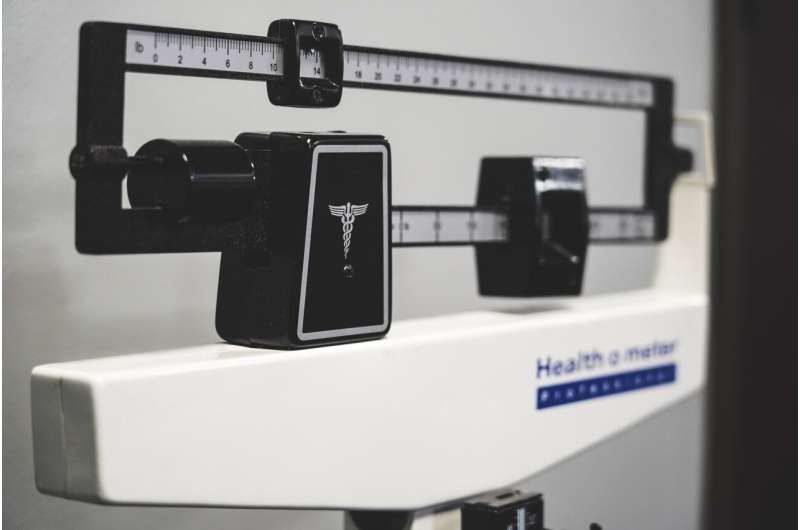This article has been reviewed according to Science X's editorial process and policies. Editors have highlighted the following attributes while ensuring the content's credibility:
fact-checked
peer-reviewed publication
trusted source
proofread
Exercise-mimicking drug sheds weight, boosts muscle activity in mice

A brand-new kind of drug, tested in mice, shows promising new results that could lead to the development of a new weight-loss drug that mimics exercise.
The new compound, developed and tested by a University of Florida professor of pharmacy and his colleagues, leads obese mice to lose weight by convincing the body's muscles that they are exercising more than they really are, boosting the animals' metabolism.
It also increases endurance, helping mice run nearly 50% further than they could before, all without the mice lifting a paw.
The drug belongs to a class known as "exercise mimetics," which provide some of the benefits of exercise without increasing physical activity. The new treatment is in the early stages of development but could one day be tested in people to treat diseases like obesity, diabetes, and age-related muscle loss. The research comes as drugs like Ozempic have provided a breakthrough in reducing appetite, helping treat these metabolic diseases.
But the new drug, known as SLU-PP-332, doesn't affect appetite or food intake. Nor does it cause mice to exercise more. Instead, the drug boosts a natural metabolic pathway that typically responds to exercise. In effect, the drug makes the body act like it is training for a marathon, leading to increased energy expenditure and faster metabolism of fat in the body.
"This compound is basically telling skeletal muscle to make the same changes you see during endurance training," said Thomas Burris, a professor of pharmacy at UF who led the recent research into the new drug.
"When you treat mice with the drug, you can see that their whole body metabolism turns to using fatty acids, which is very similar to what people use when they are fasting or exercising," Burris added. "And the animals start losing weight."
With a team of researchers at Washington University in St. Louis and St. Louis University, Burris published his findings Sept. 22 in the Journal of Pharmacology and Experimental Therapeutics.
The new drug targets a group of proteins in the body known as ERRs, which are responsible for activating some of the most important metabolic pathways in energy-gobbling tissues like muscles, the heart, and the brain. The ERRs are more active when people exercise, but they have proven difficult to activate with drugs.
In another paper published in March in ACS Chemical Biology, the researchers reported that they had successfully designed SLU-PP-332 to boost activity of the ERRs. They also observed that the compound allowed normal-weight mice to run for 70% longer and 45% further than mice not receiving the drug.
In their latest research, the team tested the drug on obese mice. Treating obese mice twice a day for a month caused them to gain 10 times less fat than untreated mice and lose 12% of their body weight. Yet the mice kept eating the same amount of food and didn't exercise any more.
"They use more energy just living," Burris said.
In other work the Burris lab is about to publish, the researchers have seen evidence that the compound can also treat heart failure in mice by strengthening the heart muscle.
So far, the drug hasn't generated any severe side effects. The next step in developing SLU-PP-332 into a drug candidate will be to refine its structure, ideally making it available as a pill instead of an injection. Then the drug would be tested for side effects in more animal models before making the jump to human trials.
Other exercise mimetics have been tested, but none have made it to market, in part because it takes years to develop a new drug. Specifically targeting obesity with a drug has historically been difficult because of how complex obesity is. That was until Ozempic, Wegovy, and Mounjaro, developed to treat diabetes, also caused people to lose weight. This development led to a surge of interest, research, and funding for drugs that could treat these metabolic diseases through different biological pathways.
Burris says the greatest hope for the new drug might be in maintaining muscle mass during weight loss—which often threatens lean muscle mass—or during aging, when the body naturally responds less strongly to exercise. But it will take more research to understand the drug's full potential.
"This may be able to keep people healthier as they age," Burris said.
More information: Cyrielle Billon et al, A Synthetic ERR Agonist Alleviates Metabolic Syndrome, Journal of Pharmacology and Experimental Therapeutics (2023). DOI: 10.1124/jpet.123.001733
Cyrielle Billon et al, Synthetic ERRα/β/γ Agonist Induces an ERRα-Dependent Acute Aerobic Exercise Response and Enhances Exercise Capacity, ACS Chemical Biology (2023). DOI: 10.1021/acschembio.2c00720





















